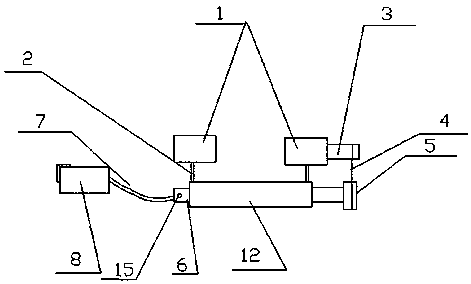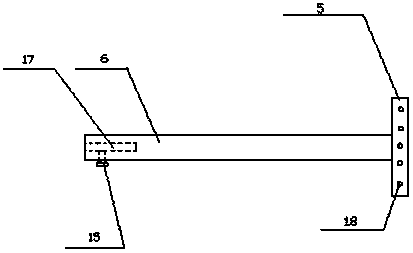Mandibular second molar torque control device
A torque control, mandibular technology, applied in brackets, arch wires, etc., can solve the problems of stimulating the patient's mucous membrane, limited space, hyperplasia, etc., and achieve the effect of controllable force value, compact device, and simple operation.
- Summary
- Abstract
- Description
- Claims
- Application Information
AI Technical Summary
Problems solved by technology
Method used
Image
Examples
Embodiment 1
[0028] combine Figure 1-4 The structure of the present invention will be described.
[0029] The torque control device for mandibular second molars is used to treat inclined mandibular second molars, and the inclined mandibular second molars are abbreviated as teeth to be treated. The mandibular second molar torque control device uses the mandibular first molar on the same side as the tooth to be treated, the mandibular second premolar and the mandibular first molar on the opposite side as anchorage teeth, and the mandibular second molar torque control device includes an attachment The mandibular first molars on the same side as the teeth to be treated, the first base plate 1 on the buccal side of the mandibular second premolars, the bracket attached to the lingual side of the mandibular left and right first molars, and the rotation set under the first base plate 1 Parts, buccal tube 8 attached to the buccal side of the tooth to be treated, NITI wire 7 between the rotating p...
Embodiment 2
[0038] Embodiment 2 The usage method of the present invention
[0039] (1) The device in Example 1 was used to correct the lingually inclined mandibular right second molar 9, and the root of the second molar was in the buccal position, specifically as follows Figure 5 and 6 shown.
[0040]In Example 1, the installation position of the device in the vertical direction is based on not affecting the occlusion of the opposing teeth. The anchorage tooth surface is acid-etched, rinsed and then coated with adhesive. The bottom surface of the second bottom plate 21 is coated with fluid resin, the bracket is attached to the lingual side of the mandibular left and right first molars, and the arched rod 20 fits the tissue surface 1-2 mm from the root of the mandibular gingival margin. The bottom surface of the first base plate 1 is coated with fluid resin, the thickness of the fluid resin between the mandibular right second premolar 11 and the corresponding base plate is greater than...
PUM
 Login to View More
Login to View More Abstract
Description
Claims
Application Information
 Login to View More
Login to View More - R&D
- Intellectual Property
- Life Sciences
- Materials
- Tech Scout
- Unparalleled Data Quality
- Higher Quality Content
- 60% Fewer Hallucinations
Browse by: Latest US Patents, China's latest patents, Technical Efficacy Thesaurus, Application Domain, Technology Topic, Popular Technical Reports.
© 2025 PatSnap. All rights reserved.Legal|Privacy policy|Modern Slavery Act Transparency Statement|Sitemap|About US| Contact US: help@patsnap.com



